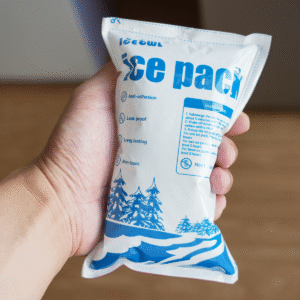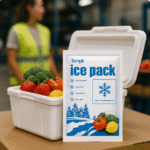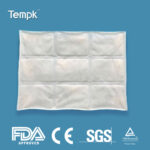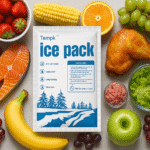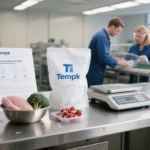If you need dry ice packs for shipping frozen food 72 hours, here’s the proven playbook. You’ll size refrigerant fast (plan 15–30 lb for most boxes), pack for reliable hold times, and pass 2025 acceptance checks without guesswork. You’ll also see when to add VIP insulation or −20 °C PCM to cut weight, plus simple lane tests to validate your box before scaling.
-
How much dry ice to plan for 72 hours on real lanes (rule‑of‑thumb + fine‑tuning)
-
How to pack and vent boxes so food stays ≤0 °F (−18 °C) end‑to‑end
-
Which 2025 labels and documents you need for air, ground, and USPS
-
When PCMs help dry ice packs for shipping frozen food 72 hours cut costs and weight
How many dry ice packs for shipping frozen food 72 hours do you need?
Start with 15–30 lb per shipper for 72 hours, then adjust for insulation, heat, and openings. The baseline reflects typical sublimation of ~5–10 lb per 24 h in insulated parcels. For hot lanes or thin EPS, move toward the top of the range; for VIP shippers, you can often reduce total mass. Always validate with a test carton on your lane.
Why it works: Dry ice removes heat as it sublimates; hold time is driven more by heat leak (insulation + temperature difference) than by payload weight. Blocks last longer than pellets. Pre‑frozen product and pre‑chilled packaging lower the initial “pull‑down,” stretching your 72‑hour buffer.
Dry ice packs for shipping frozen food 72 hours: quick estimator
Use this fast, conservative sizing flow:
-
Baseline: 72 h × (5–10 lb/day) → 15–30 lb.
-
Heat adjustment: +20% for heat waves or thin EPS; −20% with VIP.
-
Handling: +10–20% if boxes may be opened during handoffs.
-
Form factor: Prefer blocks (slower loss) and use pellets only to fill gaps.
-
Round up: Choose the next pack size; delays happen.
| 72‑Hour Planning Scenarios | Baseline Dry Ice | Adjustment | What it means to you |
|---|---|---|---|
| EPS 1.5–2″, mild route (18–24 °C) | 15–20 lb | 0–+10% | Lower end is fine if voids are filled tightly |
| EPS 2″, hot route (29–35 °C) | 20–30 lb | +20% | Budget top‑of‑range mass in summer |
| VIP shipper (pre‑qualified) | 10–20 lb | −20% | Similar hold time with less weight |
| Frequent door opens (B2B) | 15–30 lb | +10–20% | Each open dumps cold—oversize refrigerant |
Practical tips and scenarios
-
Small, loosely packed box in summer: Use more blocks on top; fill voids to curb convection.
-
Long air leg: Expect faster loss at altitude; plan toward the high end.
-
Oversized payload: Center product; add side blocks to protect from warm walls.
Field result: A 2″ EPS shipper with 24–30 lb dry ice moved 12 lb frozen meals Phoenix→Miami in July and arrived ≤−18 °C after ~72 h. VIP reduced dry ice mass by ~30% on the same lane.
How do you pack dry ice packs for shipping frozen food 72 hours safely?
Pack cold, layer smart, and vent. Pre‑freeze product to ≤0 °F (−18 °C), pre‑chill the shipper, place product centrally, put most dry ice on top (cold sinks), fill voids with breathable dunnage, and never seal airtight. Mark the same face with UN1845, Class 9, and net dry ice weight (kg).
Why details matter: Starting colder shrinks early sublimation spikes. Top‑layer ice maintains a cold gradient as CO₂ descends. Venting is required to prevent pressure buildup. Blocks reduce surface area and last longer than pellets.
Verified 72‑hour packouts for dry ice packs for shipping frozen food 72 hours
Layout A (EPS, budget): Lined cavity, product centered, dry ice top + sides, minimal voids. Total: 15–30 lb.
Layout B (VIP, premium): Thin VIP panels, dry ice top, −20 °C PCM on sides for stability. Total: 10–20 lb.
Both layouts achieve 72 h when conditioned and vented correctly; VIP can reach 72–96 h.
| Packout BOM | EPS 72 h | VIP 72–96 h | What it means to you |
|---|---|---|---|
| Insulation | 1.5–2″ EPS | Pre‑qualified VIP | VIP cuts weight and extends hold |
| Refrigerant | 15–30 lb dry ice | 10–20 lb dry ice + optional −20 °C PCM | Hybrid stabilizes temps |
| Liner & dunnage | Poly liner + kraft/bubble | Poly liner + tight fit | Keep vent paths visible |
| Labels | UN1845, Class 9, net kg | UN1845, Class 9, net kg | Place on same face when possible |
User‑ready packout checklist
-
Product ≤0 °F? Probe temp just before sealing.
-
Vent path visible? Do not over‑tape inner lid.
-
UN1845 + Class 9 + net kg on same face? Write weight in kg.
-
Logger started? USB/Bluetooth helps QA and claims.
What 2025 labels and rules apply to dry ice packs for shipping frozen food 72 hours?
Air (IATA DGR 66th): Proper name “Dry Ice”/“Carbon dioxide, solid,” UN1845, Class 9 label (100 mm), net dry ice weight in kg, and vented packaging per PI 954. Expect tighter acceptance checks in 2025.
Ground (US 49 CFR 173.217): Package must vent CO₂; prudent marking recommended.
USPS (domestic): Air ≤ 5 lb dry ice per piece; international prohibited. Mark contents cooled + net weight.
| Mode | Allowed? | Key limits | What to mark |
|---|---|---|---|
| IATA/ICAO Air | Yes | PI 954; overpack shows total net weight | “Dry Ice/CO₂ solid,” UN1845, net kg, Class 9 |
| UPS Ground (U.S. 48) | Yes | Not hazmat like air; must vent | “Dry Ice, UN1845,” net kg (good practice) |
| USPS Domestic | Yes | ≤5 lb by air; surface can exceed | Contents + “Dry Ice, UN1845,” net weight |
Safety musts: Vent always; use gloves; pack in ventilated spaces. Occupational limits: CO₂ PEL 5,000 ppm (8‑h TWA); IDLH 40,000 ppm.
When should you pair PCMs with dry ice packs for shipping frozen food 72 hours?
Use −20 °C PCM to stabilize product and reduce total dry ice—especially in VIP shippers. PCMs are reusable and non‑DG; dry ice still wins for deep‑freeze lanes or >96 h. Place PCM against product and dry ice on top; PCM smooths spikes during handoffs while dry ice carries the 72‑h load.
Decision cues for your lane
-
Deep freeze (≤−20 °C) in summer? Dry ice or VIP hybrid.
-
Tight temp band (−10 to −5 °F) and simpler paperwork? −20 °C PCM or PCM + small top‑load dry ice.
-
High uncertainty or weekend risk? VIP + dry ice to extend past 120 h.
2025 trends for dry ice packs for shipping frozen food 72 hours
What’s new: IATA DGR 66th (effective Jan 1, 2025) emphasizes declared net dry‑ice mass and proper PI 954 venting. VIP adoption is rising (R‑values ~36–50) with validated 72/96‑h lanes. Bluetooth loggers (often sub‑$100) are now common in parcel‑scale QA. FDA has proposed shifting FSMA 204 traceability compliance to July 20, 2028, giving shippers more runway.
Latest at a glance
-
DGR acceptance: Expect stricter net‑kg checks at tender.
-
VIP + PCM: Longer holds with less refrigerant; higher box cost, lower ship weight.
-
Monitoring: Wireless loggers simplify audits and refunds.
Market insight: Demand for temperature loggers continues to grow (multi‑hundred‑million market by 2030) as food and pharma raise documentation standards; expect tighter proof of control for 72‑hour frozen parcels.
FAQs
How much dry ice for 72 hours?
Plan 15–30 lb per box, then adjust for season, insulation, and openings; verify with a lane test.
What temperature should product stay at?
Keep frozen foods at 0 °F (−18 °C) or below from pack‑out to delivery.
Can I ship with USPS?
Yes, domestic only. Air ≤5 lb; surface can exceed with required marks; international is prohibited.
Do I need a Shipper’s Declaration?
When dry ice cools non‑DG goods, many operators accept airbill entries (UN1845, net kg) without a full declaration—follow the 2025 job aid.
Summary & recommendations
Bottom line: Dry ice packs for shipping frozen food 72 hours are dependable when you (1) plan 15–30 lb per shipper, (2) upgrade insulation or add VIP on hot lanes, (3) layer top/bottom blocks and fill voids, (4) vent and mark UN1845, Class 9, net kg, and (5) run a quick 72‑hour lane test with a logger. Lock your SOP with photos and a one‑page checklist.
Next steps (CTA):
-
Pilot EPS vs. VIP on your hottest lane. 2) Add a Bluetooth logger and confirm ≤−18 °C to delivery. 3) Standardize labels/marks for 2025 acceptance. Book a free 20‑minute route review with Tempk to right‑size your 72‑hour frozen packouts.
About Tempk
We design validated frozen shipping systems for 72–96‑hour lanes using EPS or VIP, with optional −20 °C PCM to reduce dry ice mass. Our packaging team instruments test cartons, tunes packouts, and helps you pass acceptance checks the first time—lower weight, fewer claims, and consistent delivery. Talk to us to blueprint your lane.






